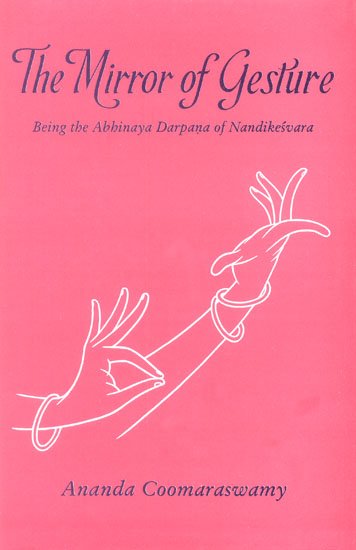Abhinaya-darpana (English)
by Ananda Coomaraswamy | 1917 | 16,981 words | ISBN-13: 9788121500210
The English translation of the Abhinaya-darpana (“the mirror of gesture”) by Nandikeshvara: an encyclopedic manual of the art of gesticulation. It belongs to a wide range of literature known as Natya-shastra: the ancient Indian art of dramatic performance, theatrics, dance and music. The Abhinaya Darpana is an abridgement of the Bharatarnava, a m...
Chapter 26 - Hands denoting Animals
Hands that indicate the Lion and other Animals.—
Lion, the Siṃha-mukha hand, i. e., right hand Siṃha-mukha, and left hand Patāka applied to the back of the right, the fingers being freely moved;
Tiger, the Ardha-candra hand held face downwards;
Boar, the Saṅkīrṇa-makara hand, i. e. in the aforesaid Matsya hand, the right hand is held downwards and shaken, the five fingers being severally held apart, indicating bristles;
Monkey, the Adho-muṣṭi-mukula hand is used, i. e. the thumb and second finger of the Muṣṭi hand are joined;
Bear, left hand Padmakośa face downwards, right hand Patāka placed on the back of the left;
Cat, the Ardha-mukula hand, i. e. the thumb and third finger of the Muṣṭi hand are joined;
Yak, the hands touching at the wrists, left hand Muṣṭi, right hand Mudrikā, making the Muṣṭi-mudrā hand;
Iguana, Tala-patāka hand, i. e. the thumb and little finger of the Patāka hand are slightly raised;
Porcupine Deer, the Candra-mṛga hand, i. e. the forefinger of the Mṛga hand is raised;
Antelope, the Mṛga-śīrṣa hand;
Black Antelope, the Muṣṭi-mrga hand, i. e. the thumb and little finger of the Muṣṭi hand are extended;
Mule, Nāga-bandha hands directed upwards, indicating ‘Cow-ear’;
Mouse, the Khaṇḍa-mukula hand, i. e. the forefinger of the Mukula hand is fully extended;
Mole (?) (girikā), the Khaḍga-mukula hand, i. e. the forefinger of the Mukula hand is bent and moved to and fro (tiryak prasārita);
Hare, the Tala-patāka hand is moved horizontally (tiryak);
Scorpion, the Karkaṭa hand is directed downwards;
Dog, the Madhya-patāka hand, i. e. the little ñnger of the Patāka hand is bent;
Camel, the Kaṇḍāñjali hand, i. e. the thumbs of the Añjali hand are bent and moved up and down;
Goat, Śikhara hands in contact face to face;
Ass, the Bhinnāñjali hand, i. e. the forefingers of the Khaṇḍāñjali hand are bent in contact;
Bull, the Tala-siṃha[1] hand, i. e. the second and third fingers are bent to touch the palm, and the thumb placed over them, and the two other fingers extended;
Cow, the Saṅkīrṇa-mudrā hand, i. e. the middle finger is bent, and all the others extended, also indicating Yantra-bheda.
Footnotes and references:
[1]:
i. e. Siṃha-mukha, with the back of the hand in the horizontal plane. Plate XIII A.
